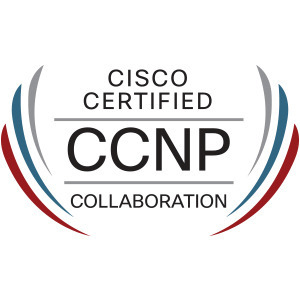
CCNP Collaboration
Prerequisites
The knowledge and skills that a learner must have before attending this course are as follows:
- Working knowledge of fundamental terms and concepts of computer networking including LANs, WANs, and IP switching and routing.
- Ability to configure and operate Cisco IOS routers in IP environment at the CCNA level.
- Basic knowledge of traditional voice, converged voice, and data networks at the CCNA Voice level.
Course Content
Implementing Cisco Voice Communications and QoS (CVOICE) v8.0 teaches learners about voice gateways, characteristics of VoIP call legs, dial plans and their implementation, basic implementation of IP phones in Cisco Unified Communications Manager Express environment and essential information about gatekeepers and Cisco Unified Border Element. The course provides the learners with voice-related QoS mechanisms that are required in Cisco Unified Communications networks.
Course Objectives
Upon completing this course, the learner will be able to meet these overall objectives:
- Explain what a voice gateway is, how it works, and describe its usage, components, and features.
- Describe the characteristics and configuration elements of VoIP call legs.
- Describe how to implement IP phones using Cisco Unified Communications Manager Express.
- Describe the components of a dial plan and explain how to implement a dial plan on a Cisco Unified voice gateway.
- Explain what gatekeepers and Cisco Unified Border Elements are, how they work, and what features they support.
- Describe why QoS is needed, what functions it performs, and how it can be implemented in a Cisco Unified Communications network.
Course Outline
Course Introduction
- Introduction to Voice Gateways
- VoIP Call Legs
- Cisco Unified Communications Manager Express Endpoints Implementation
- Dial Plan Implementation
- Gatekeeper and Cisco Unified Border Element Implementation
- Quality of Service
Prerequisites
The knowledge and skills that a learner must have before attending this course are as follows:
- Working knowledge of fundamental terms and concepts of computer networking including LANs.
- WANs, and IP switching and routing.
- Ability to configure and operate Cisco routers and switches and to enable VLANs and DHCP.
- Basics of digital interfaces, PSTN, and VoIP.
- Fundamental knowledge of converged voice and data networks.
- Ability to configure Cisco IOS gateways with traditional and VoIP call legs.
Course Content
Implementing Cisco Unified Communications Manager, Part 1 (CIPT1) v8.0 prepares you for implementing a Cisco Unified Communications Manager solution at a single-site environment. This course focuses primarily on Cisco Unified Communications Manager version 8.0, which is the call routing and signaling component for the Cisco Unified Communications solution. You will perform post-installation tasks, configure Cisco Unified Communications Manager, implement Media Gateway Control Protocol (MGCP) and H.323 gateways, and build dial plans to place on-net and off-net phone calls. You will also implement media resources, IP Phone Services, Cisco Unified Communications Manager native presence, and Cisco Unified Mobility.
Course Objectives
Upon completing this course, the learner will be able to meet these overall objectives:
- Describe Cisco Unified Communications Manager, including its functions, architecture, deployment and redundancy options, and how to install or upgrade.
- Perform Cisco Unified Communications Manager initial configuration and user management.
- Configure Cisco Unified Communications Manager to support on-cluster calling.
- Implement PSTN access in Cisco Unified Communications Manager and to build a dial plan in a single-site Cisco.
- Implement Cisco Unified Communications Manager media resources.
- Implement Cisco Unified Communications Manager features and applications.
Course Outline
Course Introduction
- Introduction to Cisco Unified Communications Manager
- Enabling Single-Site On-Net Calling
- Single-Site Off-Net Calling
- Media Resources
- Feature and Application Implementation
Prerequisites
The knowledge and skills that a learner must have before attending this course are as follows:
- Working knowledge of converged voice and data networks.
- Working knowledge of the MGCP, SIP, and H.323 protocols and their implementation on Cisco IOS gateways.
- Ability to configure and operate Cisco routers and switches.
- Ability to configure and operate Cisco Unified Communications Manager in a single-site environment.
Course Content
Implementing Cisco Unified Communications Manager, Part 2 (CIPT2) v8.0 prepares you for implementing Cisco Unified Communications solution in a multisite environment. It covers globalized call routing, Cisco Service Advertisement Framework (SAF) and Call Control Discovery (CCD), tail-end hop-off (TEHO), Cisco Unified Survivable Remote Site Telephony (SRST), and mobility features such as Cisco Device Mobility and Cisco Extension Mobility. You will apply a dial plan for a multisite environment including TEHO, configure survivability for remote sites during WAN failure and implement solutions to reduce bandwidth requirements in the IP WAN. You will also enable Call Admission Control (CAC) including Session Initiation Protocol (SIP) Preconditions and automated alternate routing (AAR).
Course Objectives
Upon completing this course, the learner will be able to meet these overall objectives:
- Describe multisite deployment issues and solutions, and describe and configure required dial plan elements.
- Implement call-processing resiliency in remote sites by using Cisco Unified SRST, MGCP fallback, and Cisco Unified Communications Manager Express in Cisco Unified SRST mode.
- Implement bandwidth management and CAC to prevent oversubscription of the IP WAN.
- Implement Device Mobility and Cisco Extension Mobility.
- Describe and implement CCD deployments.
Course Outline
Overview
- Learner Prerequisite Skills and Knowledge
- Course Goal and Objectives
- Course Flow
- Additional References
- Your Training Curriculum
Prerequisites
The knowledge and skills that a learner must have before attending this course are as follows:
- Working knowledge of converged voice and data networks.
- Working knowledge of the MGCP, SIP, and H.323 and their implementation on Cisco IOS gateways.
- Working knowledge of Cisco Unified Communications Manager, Cisco Unified Communications features and applications, and Cisco IOS voice gateways in a single-site and multisite environment.
Course Content
Troubleshooting Cisco Unified Communications (TVOICE) v8.0 prepares network professionals with the knowledge and skills that are required to troubleshoot Cisco Unified Communications systems and solutions in enterprise, midmarket, and commercial deployments in single-site and multisite environments. The course teaches troubleshooting methodology, triage, resources, tools, and fixes at the integrated system or solution level for Cisco Unified Communications Manager.
Course Objectives
Upon completing this course, the learner will be able to meet these overall objectives:
- Describe a systematic methodology to troubleshoot Cisco Unified Communications solutions
- Isolate and troubleshoot reported issues that relate to Cisco Unified Communications Manager.
- Diagnose a call setup issue and resolve the issues as you discover or reveal them, given a trouble call for which the source of the problem is unknown.
- Solve the common issues of an SAF-enabled network and CCD.
- Troubleshoot issues that are related to Cisco Unified Communications Manager features and applications.
- Troubleshoot voice quality issues and issues that are related to media resources.
Course Outline
Overview
- Learner Prerequisite Skills and Knowledge
- Course Goal and Objectives
- Course Flow
- Additional References
- Your Training Curriculum
Prerequisites
The knowledge and skills that a learner must have before attending this course are as follows:
- Working knowledge of converged voice and data networks.
- Basic knowledge of Cisco IOS gateways.
- Working knowledge of Cisco Unified Communications Manager and Cisco Unity Connection.
- Cisco CCNA certification recommended prerequisite.
Course Content
Integrating Cisco Unified Communications Applications (CAPPS) v8.0 teaches learners the integration options of Cisco Unified Presence, Cisco Unity Express, and Cisco Unity Connection. It describes voice messaging deployment scenarios, Cisco Unified Presence features, and troubleshooting mechanisms as well as Cisco Unified Presence and Cisco Unified Personal Communicator integration options with Cisco Unified Communications Manager.
Course Objectives
Upon completing this course, the learner will be able to meet these overall objectives:
- Describe voice-mail integration options and requirements.
- Cisco Unity Connection in a Cisco Unified Communications Manager deployment.
- Describe how to implement Cisco Unity Express in a Cisco Unified Communications Manager Express deployment.
- Implement voice-mail networking using VPIM.
- Implement Cisco Unified Presence and Cisco Unified Personal Communicator.
Course Outline
Course Introduction
- Introduction to Voice Mail
- Cisco Unity Connection in a Cisco Unified Communications Manager Environment
- Cisco Unity Express Implementation in Cisco Unified Communications Manager Express Environment
- Voice Profile for Internet Mail Implementation
- Cisco Unified Presence Implementation
